Assessing Mineral Content and Heavy Metal Exposure in Abruzzo Honey and Bee Pollen from Different Anthropic Areas
Abstract
:1. Introduction
2. Materials and Methods
2.1. Sample Collection
2.2. Corine Land Cover Use of Soil
2.3. Sample Preparation
2.4. ICP-MS Analysis of Elements
2.5. Risk Assessment
2.5.1. Non-Carcinogenic Risk
2.5.2. Carcinogenic Risk
2.6. Statistical Analysis
3. Results
3.1. Use of Soil and Characterization of the Flight Areas (CLC)
3.2. Mineral Contents of Honey and Bee Pollen Samples
3.3. Carcinogenic and Non-Carcinogenic Effects in Bee Pollen and Honey
3.3.1. Non-Carcinogenic Risk (EDI, THQm, HI)
3.3.2. Carcinogenic Risk (LCTR)
3.4. PCA
3.5. HCA
4. Conclusions
Supplementary Materials
Author Contributions
Funding
Institutional Review Board Statement
Informed Consent Statement
Data Availability Statement
Acknowledgments
Conflicts of Interest
References
- Boukraâ, L. Honey in Traditional and Modern Medicine; CRC Press: Boca Raton, FL, USA, 2022. [Google Scholar]
- Scivicco, M.; Squillante, J.; Velotto, S.; Esposito, F.; Cirillo, T.; Severino, L. Dietary Exposure to Heavy Metals through Polyfloral Honey from Campania Region (Italy). J. Food Compos. Anal. 2022, 114, 104748. [Google Scholar] [CrossRef]
- Da Silva, P.M.; Gauche, C.; Gonzaga, L.V.; Costa, A.C.O.; Fett, R. Honey: Chemical Composition, Stability and Authenticity. Food Chem. 2016, 196, 309–323. [Google Scholar] [CrossRef]
- Khan, S.U.; Anjum, S.I.; Rahman, K.; Ansari, M.J.; Khan, W.U.; Kamal, S.; Khattak, B.; Muhammad, A.; Khan, H.U. Honey: Single Food Stuff Comprises Many Drugs. Saudi J. Biol. Sci. 2018, 25, 320–325. [Google Scholar] [CrossRef]
- Sakač, M.B.; Jovanov, P.T.; Marić, A.Z.; Pezo, L.L.; Kevrešan, Ž.S.; Novaković, A.R.; Nedeljković, N.M. Physicochemical Properties and Mineral Content of Honey Samples from Vojvodina (Republic of Serbia). Food Chem. 2019, 276, 15–21. [Google Scholar] [CrossRef]
- Wang, H.; Li, L.; Lin, X.; Bai, W.; Xiao, G.; Liu, G. Composition, Functional Properties and Safety of Honey: A Review. J. Sci. Food Agric. 2023, 103, 6767–6779. [Google Scholar] [CrossRef]
- Aga, M.B.; Sharma, V.; Dar, A.H.; Dash, K.K.; Singh, A.; Shams, R.; Khan, S.A. Comprehensive Review on Functional and Nutraceutical Properties of Honey. eFood 2023, 4, e71. [Google Scholar] [CrossRef]
- ISMEA. Mercati Api e Miele—News e Analisi—Tendenze. Available online: https://www.ismeamercati.it/flex/cm/pages/ServeBLOB.php/L/IT/IDPagina/12812 (accessed on 3 May 2024).
- Barbieri, D.; Gabriele, M.; Summa, M.; Colosimo, R.; Leonardi, D.; Domenici, V.; Pucci, L. Antioxidant, Nutraceutical Properties, and Fluorescence Spectral Profiles of Bee Pollen Samples from Different Botanical Origins. Antioxidants 2020, 9, 1001. [Google Scholar] [CrossRef]
- Khalifa, S.A.M.; Elashal, M.H.; Yosri, N.; Du, M.; Musharraf, S.G.; Nahar, L.; Sarker, S.D.; Guo, Z.; Cao, W.; Zou, X.; et al. Bee Pollen: Current Status and Therapeutic Potential. Nutrients 2021, 13, 1876. [Google Scholar] [CrossRef]
- Kostić, A.; Milinčić, D.D.; Barać, M.B.; Shariati, M.A.; Tešić, Ž.L.; Pešić, M.B. The Application of Pollen as a Functional Food and Feed Ingredient—The Present and Perspectives. Biomolecules 2020, 10, 84. [Google Scholar] [CrossRef]
- Mohdaly, A.A.A.; Mahmoud, A.A.; Roby, M.H.H.; Smetanska, I.; Ramadan, M.F. Phenolic Extract from Propolis and Bee Pollen: Composition, Antioxidant and Antibacterial Activities. J. Food Biochem. 2015, 39, 538–547. [Google Scholar] [CrossRef]
- Végh, R.; Csóka, M.; Sörös, C.; Sipos, L. Food Safety Hazards of Bee Pollen—A Review. Trends Food Sci. Technol. 2021, 114, 490–509. [Google Scholar] [CrossRef]
- Atamaleki, A.; Yazdanbakhsh, A.; Fakhri, Y.; Mahdipour, F.; Khodakarim, S.; Mousavi Khaneghah, A. The Concentration of Potentially Toxic Elements (PTEs) in the Onion and Tomato Irrigated by Wastewater: A Systematic Review; Meta-Analysis and Health Risk Assessment. Food Res. Int. 2019, 125, 108518. [Google Scholar] [CrossRef]
- World Health Organization; Food and Agriculture Organization of the United Nations; International Atomic Energy Agency. Trace Elements in Human Nutrition and Health; World Health Organization: Geneva, Switzerland, 1996; p. 343. [Google Scholar]
- Squadrone, S.; Brizio, P.; Stella, C.; Pederiva, S.; Brusa, F.; Mogliotti, P.; Garrone, A.; Abete, M.C. Trace and Rare Earth Elements in Monofloral and Multifloral Honeys from Northwestern Italy; A First Attempt of Characterization by a Multi-Elemental Profile. J. Trace Elem. Med. Biol. 2020, 61, 126556. [Google Scholar] [CrossRef]
- Walker, C.H. Neurotoxic Pesticides and Behavioural Effects Upon Birds. Ecotoxicology 2003, 12, 307–316. [Google Scholar] [CrossRef]
- Perna, A.M.; Grassi, G.; Gambacorta, E.; Simonetti, A. Minerals Content in Basilicata Region (Southern Italy) Honeys from Areas with Different Anthropic Impact. Int. J. Food Sci. Technol. 2021, 56, 4465–4472. [Google Scholar] [CrossRef]
- Villanueva, R.; Bustamante, P. Composition in Essential and Non-Essential Elements of Early Stages of Cephalopods and Dietary Effects on the Elemental Profiles of Octopus Vulgaris Paralarvae. Aquaculture 2006, 261, 225–240. [Google Scholar] [CrossRef]
- Alqarni, A.S.; Owayss, A.A.; Mahmoud, A.A.; Hannan, M.A. Mineral Content and Physical Properties of Local and Imported Honeys in Saudi Arabia. J. Saudi Chem. Soc. 2014, 18, 618–625. [Google Scholar] [CrossRef]
- Tchounwou, P.B.; Yedjou, C.G.; Patlolla, A.K.; Sutton, D.J. Heavy Metal Toxicity and the Environment. In Molecular, Clinical and Environmental Toxicology. Experientia Supplementum; Springer: Basel, Switzerland, 2012; Volume 101, pp. 133–164. [Google Scholar]
- Briffa, J.; Sinagra, E.; Blundell, R. Heavy Metal Pollution in the Environment and Their Toxicological Effects on Humans. Heliyon 2020, 6, e04691. [Google Scholar] [CrossRef]
- Scutarașu, E.C.; Trincă, L.C. Heavy Metals in Foods and Beverages: Global Situation, Health Risks and Reduction Methods. Foods 2023, 12, 3340. [Google Scholar] [CrossRef]
- Gautam, P.K.; Gautam, R.K.; Chattopadhyaya, M.C.; Banerjee, S.; Chattopadhyaya, M.C.; Pandey, J.D. Heavy Metals in the Environment: Fate, Transport, Toxicity and Remediation Technologies; Nova Science Publishers: Hauppauge, NY, USA, 2016. [Google Scholar]
- Squadrone, S.; Brizio, P.; Stella, C.; Mantia, M.; Pederiva, S.; Brusa, F.; Mogliotti, P.; Garrone, A.; Abete, M.C. Trace Elements and Rare Earth Elements in Honeys from the Balkans, Kazakhstan, Italy, South America, and Tanzania. Environ. Sci. Pollut. Res. 2020, 27, 12646–12657. [Google Scholar] [CrossRef]
- Zambelli, B.; Uversky, V.N.; Ciurli, S. Nickel Impact on Human Health: An Intrinsic Disorder Perspective. Biochim. Biophys. Acta Proteins Proteom. 2016, 1864, 1714–1731. [Google Scholar] [CrossRef]
- Erdoğan, A.; Şeker, M.E.; Kahraman, S.D. Evaluation of Environmental and Nutritional Aspects of Bee Pollen Samples Collected from East Black Sea Region, Turkey, via Elemental Analysis by ICP-MS. Biol. Trace Elem. Res. 2023, 201, 1488–1502. [Google Scholar] [CrossRef]
- Sharma, A.; Pant, K.; Brar, D.S.; Thakur, A.; Nanda, V. A Review on Api-Products: Current Scenario of Potential Contaminants and Their Food Safety Concerns. Food Control 2023, 145, 109499. [Google Scholar] [CrossRef]
- World Health Organization. Lead Poisoning. Available online: https://www.who.int/news-room/fact-sheets/detail/lead-poisoning-and-health (accessed on 3 May 2024).
- European Commission. EU Regulation 2023/915; European Commission: Brussels, Belgium, 2023. [Google Scholar]
- Liolios, V.; Tananaki, C.; Papaioannou, A.; Kanelis, D.; Rodopoulou, M.A.; Argena, N. Mineral Content in Monofloral Bee Pollen: Investigation of the Effect of the Botanical and Geographical Origin. J. Food Meas. Charact. 2019, 13, 1674–1682. [Google Scholar] [CrossRef]
- Morgano, M.A.; Martins, M.C.T.; Rabonato, L.C.; Milani, R.F.; Yotsuyanagi, K.; Rodriguez-Amaya, D.B. A Comprehensive Investigation of the Mineral Composition of Brazilian Bee Pollen: Geographic and Seasonal Variations and Contribution to Human Diet. Artic. J. Braz. Chem. Soc. 2012, 23, 727–736. [Google Scholar] [CrossRef]
- Wang, H.; Inukai, Y.; Yamauchi, A. Root Development and Nutrient Uptake. CRC Crit. Rev. Plant Sci. 2006, 25, 279–301. [Google Scholar] [CrossRef]
- Porrini, C.; Medrzycki, P. Avvelenamenti Da Pesticidi. In Patologia e Avversità Dell’alveare; Springer: Milan, Italy, 2014; pp. 293–323. [Google Scholar]
- Perugini, M.; Manera, M.; Grotta, L.; Abete, M.C.; Tarasco, R.; Amorena, M. Heavy Metal (Hg, Cr, Cd, and Pb) Contamination in Urban Areas and Wildlife Reserves: Honeybees as Bioindicators. Biol. Trace Elem. Res. 2011, 140, 170–176. [Google Scholar] [CrossRef]
- Couvillon, M.J.; Ratnieks, F.L.W. Environmental Consultancy: Dancing Bee Bioindicators to Evaluate Landscape “Health”. Front. Ecol. Evol. 2015, 3, 44. [Google Scholar] [CrossRef]
- Nowak, A.; Nowak, I. Review of Harmful Chemical Pollutants of Environmental Origin in Honey and Bee Products. Crit. Rev. Food Sci. Nutr. 2023, 63, 5094–5116. [Google Scholar] [CrossRef]
- González-Alcaraz, M.N.; Malheiro, C.; Cardoso, D.N.; Prodana, M.; Morgado, R.G.; van Gestel, C.A.M.; Loureiro, S. Bioaccumulation and Toxicity of Organic Chemicals in Terrestrial Invertebrates. In Handbook of Environmental Chemistry; Springer Science and Business Media Deutschland GmbH: Berlin/Heidelberg, Germany, 2020; Volume 100, pp. 149–189. [Google Scholar]
- Borsuk, G.; Sulborska, A.; Stawiarz, E.; Olszewski, K.; Wiącek, D.; Ramzi, N.; Nawrocka, A.; Jędryczka, M. Capacity of Honeybees to Remove Heavy Metals from Nectar and Excrete the Contaminants from Their Bodies. Apidologie 2021, 52, 1098–1111. [Google Scholar] [CrossRef]
- Conti, M.E.; Canepari, S.; Finoia, M.G.; Mele, G.; Astolfi, M.L. Characterization of Italian Multifloral Honeys on the Basis of Their Mineral Content and Some Typical Quality Parameters. J. Food Compos. Anal. 2018, 74, 102–113. [Google Scholar] [CrossRef]
- Dżugan, M.; Wesołowska, M.; Zaguła, G.; Kaczmarski, M.; Czernicka, M.; Puchalski, C. Honeybees (Apis mellifera) as a Biological Barrier for Contamination of Honey by Environmental Toxic Metals. Environ. Monit. Assess. 2018, 190, 101. [Google Scholar] [CrossRef]
- Ruschioni, S.; Riolo, P.; Minuz, R.L.; Stefano, M.; Cannella, M.; Porrini, C.; Isidoro, N. Biomonitoring with Honeybees of Heavy Metals and Pesticides in Nature Reserves of the Marche Region (Italy). Biol. Trace Elem. Res. 2013, 154, 226–233. [Google Scholar] [CrossRef]
- Formicki, G.; Greń, A.; Stawarz, R.; Zyśk, B.; Gał, A. Metal Content in Honey, Propolis, Wax, and Bee Pollen and Implications for Metal Monitoring. Pol. J. Environ. Stud. 2013, 22, 99–106. [Google Scholar]
- Salkova, D.; Panayotova-Pencheva, M. Honey Bees and Their Products as Indicators of Environmental Pollution: A Review. Agric. Sci. Technol. 2016, 8, 175–182. [Google Scholar] [CrossRef]
- Copernicus Land Monitoring Service Data Viewer. Available online: https://land.copernicus.eu/en/map-viewer (accessed on 8 May 2024).
- Batista, B.L.; da Silva, L.R.S.; Rocha, B.A.; Rodrigues, J.L.; Berretta-Silva, A.A.; Bonates, T.O.; Gomes, V.S.D.; Barbosa, R.M.; Barbosa, F. Multi-Element Determination in Brazilian Honey Samples by Inductively Coupled Plasma Mass Spectrometry and Estimation of Geographic Origin with Data Mining Techniques. Food Res. Int. 2012, 49, 209–215. [Google Scholar] [CrossRef]
- Kalaycıoğlu, Z.; Kaygusuz, H.; Döker, S.; Kolaylı, S.; Erim, F.B. Characterization of Turkish Honeybee Pollens by Principal Component Analysis Based on Their Individual Organic Acids, Sugars, Minerals, and Antioxidant Activities. LWT 2017, 84, 402–408. [Google Scholar] [CrossRef]
- Conti, M.E.; Astolfi, M.L.; Finoia, M.G.; Massimi, L.; Canepari, S. Biomonitoring of Element Contamination in Bees and Beehive Products in the Rome Province (Italy). Environ. Sci. Pollut. Res. 2022, 29, 36057–36074. [Google Scholar] [CrossRef]
- Hague, T.; Petroczi, A.; Andrews, P.L.R.; Barker, J.; Naughton, D.P. Determination of Metal Ion Content of Beverages and Estimation of Target Hazard Quotients: A Comparative Study. Chem. Cent. J. 2008, 2, 13. [Google Scholar] [CrossRef]
- Ozyigit, I.I.; Karahan, F.; Yalcin, I.E.; Hocaoglu-Ozyigit, A.; Ilcim, A. Heavy Metals and Trace Elements Detected in the Leaves of Medicinal Plants Collected in the Southeast Part of Turkey. Arab. J. Geosci. 2021, 15, 27. [Google Scholar] [CrossRef]
- US EPA. Regional Screening Levels (RSLs)—User’s Guide. Available online: https://www.epa.gov/risk/regional-screening-levels-rsls-users-guide (accessed on 3 May 2024).
- Çobanoğlu, D.N.; Kizilpinar Temizer, İ.; Candan, E.D.; Yolcu, U.; Güder, A. Evaluation of the Nutritional Value of Bee Pollen by Palynological, Antioxidant, Antimicrobial, and Elemental Characteristics. Eur. Food Res. Technol. 2023, 249, 307–325. [Google Scholar] [CrossRef]
- Winiarska-Mieczan, A.; Wargocka, B.; Jachimowicz, K.; Baranowska-Wójcik, E.; Kwiatkowska, K.; Kwiecień, M. Evaluation of Consumer Safety of Polish Honey—The Content of Cd and Pb in Multifloral, Monofloral and Honeydew Honeys. Biol. Trace Elem. Res. 2021, 199, 4370–4383. [Google Scholar] [CrossRef]
- Leclercq, C.; Arcella, D.; Piccinelli, R.; Sette, S.; Le Donne, C. The Italian National Food Consumption Survey INRAN-SCAI 2005-06: Main Results: In Terms of Food Consumption. Public Health Nutr. 2009, 12, 2504–2532. [Google Scholar] [CrossRef]
- Fakhri, Y.; Abtahi, M.; Atamaleki, A.; Raoofi, A.; Atabati, H.; Asadi, A.; Miri, A.; Shamloo, E.; Alinejad, A.; Keramati, H.; et al. The Concentration of Potentially Toxic Elements (PTEs) in Honey: A Global Systematic Review and Meta-Analysis and Risk Assessment. Trends Food Sci. Technol. 2019, 91, 498–506. [Google Scholar] [CrossRef]
- Zafeiraki, E.; Kasiotis, K.M.; Nisianakis, P.; Manea-Karga, E.; Machera, K. Occurrence and Human Health Risk Assessment of Mineral Elements and Pesticides Residues in Bee Pollen. Food Chem. Toxicol. 2022, 161, 112826. [Google Scholar] [CrossRef]
- Komosinska-Vassev, K.; Olczyk, P.; Kaźmierczak, J.; Mencner, L.; Olczyk, K. Bee Pollen: Chemical Composition and Therapeutic Application. Evid.-Based Complement. Altern. Med. 2015, 2015, 297425. [Google Scholar] [CrossRef]
- Pohl, P.; Dzimitrowicz, A.; Greda, K.; Jamroz, P.; Lesniewicz, A.; Szymczycha-Madeja, A.; Welna, M. Element Analysis of Bee-Collected Pollen and Bee Bread by Atomic and Mass Spectrometry—Methodological Development in Addition to Environmental and Nutritional Aspects. TrAC—Trends Anal. Chem. 2020, 128, 115922. [Google Scholar] [CrossRef]
- Sevin, S.; Tutun, H.; Yipel, M.; Aluç, Y.; Ekici, H. Concentration of Essential and Non-Essential Elements and Carcinogenic/Non-Carcinogenic Health Risk Assessment of Commercial Bee Pollens from Turkey. J. Trace Elem. Med. Biol. 2023, 75, 127104. [Google Scholar] [CrossRef]
- Bat, L.; Şahin, F.; Öztekin, A.; Arici, E.; Yardim, Ö. Assessment of Cd, Hg, Pb, Cu and Zn Amounts in Muscles of Cyprinus Carpio from Karasu Stream, Sinop. Curr. Agric. Res. J. 2019, 7, 171–180. [Google Scholar] [CrossRef]
- Obiora, S.C.; Chukwu, A.; Chibuike, G.; Nwegbu, A.N. Potentially Harmful Elements and Their Health Implications in Cultivable Soils and Food Crops around Lead-Zinc Mines in Ishiagu, Southeastern Nigeria. J. Geochem. Explor. 2019, 204, 289–296. [Google Scholar] [CrossRef]
- Real, M.I.H.; Azam, H.M.; Majed, N. Consumption of Heavy Metal Contaminated Foods and Associated Risks in Bangladesh. Environ. Monit. Assess. 2017, 189, 651. [Google Scholar] [CrossRef]
- Ullah, R.; Jan, F.A.; Gulab, H.; Saleem, S.; Ullah, N.; Wajidullah. Metals Contents in Honey, Beeswax and Bees and Human Health Risk Assessment Due to Consumption of Honey: A Case Study from Selected Districts in Khyber Pakhtunkhwa, Pakistan. Arch. Environ. Contam. Toxicol. 2022, 82, 341–354. [Google Scholar] [CrossRef]
- Gebeyehu, H.R.; Bayissa, L.D. Levels of Heavy Metals in Soil and Vegetables and Associated Health Risks in Mojo Area, Ethiopia. PLoS ONE 2020, 15, e0227883. [Google Scholar] [CrossRef]
- Nduka, J.K.; Kelle, H.I.; Amuka, J.O. Health Risk Assessment of Cadmium, Chromium and Nickel from Car Paint Dust from Used Automobiles at Auto-Panel Workshops in Nigeria. Toxicol. Rep. 2019, 6, 449–456. [Google Scholar] [CrossRef]
- U.S. Department of Energy (DOE). The Risk Assessment Information System. Available online: https://rais.ornl.gov/cgi-bin/tools/TOX_search?select=chemtox (accessed on 3 May 2024).
- De Souza, I.D.; Melo, E.S.P.; Nascimento, V.A.; Pereira, H.S.; Silva, K.R.N.; Espindola, P.R.; Tschinkel, P.F.S.; Ramos, E.M.; Reis, F.J.M.; Ramos, I.B.; et al. Potential Health Risks of Macro- And Microelements in Commercial Medicinal Plants Used to Treatment of Diabetes. Biomed. Res. Int. 2021, 2021, 6678931. [Google Scholar] [CrossRef]
- US EPA; Superfund Health Risk Technical Support Center. Provisional Peer Reviewed Toxicity Values for Iron and Compounds (CASRN 7439-89-6); US EPA: Washington, DC, USA, 2006.
- US EPA; Superfund Health Risk Technical Support Center. Provisional Peer-Reviewed Toxicity Values for Rubidium Compounds (CASRN 7440-17-7, Rubidium) (CASRN 7791-11-9, Rubidium Chloride) (CASRN 1310-82-3, Rubidium Hydroxide) (CASRN 7790-29-6, Rubidium Iodide); US EPA: Washington, DC, USA, 2006.
- Keith, S.; Faroon, O.; Roney, N.; Scinicariello, F.; Wilbur, S.; Ingerman, L.; Llados, F.; Plewak, D.; Wohlers, D.; Diamond, G. Toxicological Profile for Uranium; U.S. Department of Health & Human Services: Washington, DC, USA, 2013. [Google Scholar]
- Health Canada. Federal Contaminated Site Risk Assessment in Canada, Part V: Guidance on Complex Human Health Detailed Quantitative Risk Assessment for Chemicals (DQRACHEM); Health Canada: Ottawa, ON, USA, 2010. [Google Scholar]
- Metsalu, T.; Vilo, J. ClustVis: A Web Tool for Visualizing Clustering of Multivariate Data Using Principal Component Analysis and Heatmap. Nucleic Acids Res. 2015, 43, W566–W570. [Google Scholar] [CrossRef]
- Astolfi, V.; Kaškonienė, V.; Kaškonas, P.; Barčauskaitė, K.; Maruška, A. Comparison of Physicochemical Properties of Bee Pollen with Other Bee Products. Biomolecules 2019, 9, 819. [Google Scholar] [CrossRef]
- Astolfi, M.L.; Conti, M.E.; Messi, M.; Marconi, E. Probiotics as a Promising Prophylactic Tool to Reduce Levels of Toxic or Potentially Toxic Elements in Bees. Chemosphere 2022, 308, 136261. [Google Scholar] [CrossRef]
- Quinto, M.; Miedico, O.; Spadaccino, G.; Paglia, G.; Mangiacotti, M.; Li, D.; Centonze, D.; Chiaravalle, A.E. Characterization, Chemometric Evaluation, and Human Health-Related Aspects of Essential and Toxic Elements in Italian Honey Samples by Inductively Coupled Plasma Mass Spectrometry. Environ. Sci. Pollut. Res. 2016, 23, 25374–25384. [Google Scholar] [CrossRef]
- Di Bella, G.; Lo Turco, V.; Potortì, A.G.; Bua, G.D.; Fede, M.R.; Dugo, G. Geographical Discrimination of Italian Honey by Multi-Element Analysis with a Chemometric Approach. J. Food Compos. Anal. 2015, 44, 25–35. [Google Scholar] [CrossRef]
- Ru, Q.M.; Feng, Q.; He, J.Z. Risk Assessment of Heavy Metals in Honey Consumed in Zhejiang Province, Southeastern China. Food Chem. Toxicol. 2013, 53, 256–262. [Google Scholar] [CrossRef]
- Perna, A.; Intaglietta, I.; Simonetti, A.; Gambacorta, E. Metals in Honeys from Different Areas of Southern Italy. Bull. Environ. Contam. Toxicol. 2014, 92, 253–258. [Google Scholar] [CrossRef]
- Ligor, M.; Kowalkowski, T.; Buszewski, B. Comparative Study of the Potentially Toxic Elements and Essential Microelements in Honey Depending on the Geographic Origin. Molecules 2022, 27, 5474. [Google Scholar] [CrossRef]
- Squadrone, S.; Brizio, P.; Stella, C.; Mantia, M.; Battuello, M.; Nurra, N.; Sartor, R.M.; Orusa, R.; Robetto, S.; Brusa, F.; et al. Rare Earth Elements in Marine and Terrestrial Matrices of Northwestern Italy: Implications for Food Safety and Human Health. Sci. Total Environ. 2019, 660, 1383–1391. [Google Scholar] [CrossRef]
- Pisani, A.; Protano, G.; Riccobono, F. Minor and Trace Elements in Different Honey Types Produced in Siena County (Italy). Food Chem. 2008, 107, 1553–1560. [Google Scholar] [CrossRef]
- Meli, M.A.; Desideri, D.; Roselli, C.; Benedetti, C.; Feduzi, L. Essential and Toxic Elements in Honeys from a Region of Central Italy. J. Toxicol. Environ. Health—Part. A Curr. Issues 2015, 78, 617–627. [Google Scholar] [CrossRef]
- Bogdanov, S. The pollen Book. In Pollen: Collection, Harvest, Composition, Quality; Chapter 1; Bogdanov, S., Ed.; Bee Product Science: Muehlethurnen, Switzerland, 2017. [Google Scholar]
- Conti, M.E.; Botrè, F. Honeybees and Their Products as Potential Bioindicators of Heavy Metals Contamination. Environ. Monit. Assess. 2001, 69, 267–282. [Google Scholar] [CrossRef]
- Lambert, O.; Piroux, M.; Puyo, S.; Thorin, C.; Larhantec, M.; Delbac, F.; Pouliquen, H. Bees, Honey and Pollen as Sentinels for Lead Environmental Contamination. Environ. Pollut. 2012, 170, 254–259. [Google Scholar] [CrossRef]
- Roman, A. Concentration of Chosen Trace Elements of Toxic Properties in Bee Pollen Loads. Pol. J. Environ. Stud. 2009, 18, 265–272. [Google Scholar]
- Begum, W.; Rai, S.; Banerjee, S.; Bhattacharjee, S.; Mondal, M.H.; Bhattarai, A.; Saha, B. A Comprehensive Review on the Sources, Essentiality and Toxicological Profile of Nickel. RSC Adv. 2022, 12, 9139–9153. [Google Scholar] [CrossRef]
- Pietrelli, L.; Menegoni, P.; Papetti, P. Bioaccumulation of Heavy Metals by Herbaceous Species Grown in Urban and Rural Sites. Water Air Soil. Pollut. 2022, 233, 141. [Google Scholar] [CrossRef]
- Catalano, P.; Della Sala, F.; Cavaliere, M.; Caputo, C.; Pecoraro, D.; Crispino, G.; Lettera, S.; Caioni, G.; Esposito, M.; Verre, A.; et al. Use of Honey Bees and Hive Products as Bioindicators to Assess Environmental Contamination in Targeted Areas of the Campania Region (Italy). Animals 2024, 14, 1446. [Google Scholar] [CrossRef]
- Farias, R.A.; Nunes, C.N.; Quináia, S.P. Bees Reflect Better on Their Ecosystem Health than Their Products. Environ. Sci. Pollut. Res. 2023, 30, 79617–79626. [Google Scholar] [CrossRef]
- Smith, K.E.; Weis, D. Evaluating Spatiotemporal Resolution of Trace Element Concentrations and Pb Isotopic Compositions of Honeybees and Hive Products as Biomonitors for Urban Metal Distribution. GeoHealth 2020, 4, e2020GH000264. [Google Scholar] [CrossRef]
- Wong, C.; Roberts, S.M.; Saab, I.N. Review of Regulatory Reference Values and Background Levels for Heavy Metals in the Human Diet. Regul. Toxicol. Pharmacol. 2022, 130, 105122. [Google Scholar] [CrossRef]
- Beshaw, T.; Demssie, K.; Leka, I. Levels and Health Risk Assessment of Trace Metals in Honey from Different Districts of Bench Sheko Zone, Southwest Ethiopia. Heliyon 2022, 8, e10535. [Google Scholar] [CrossRef]
- Obasi, N.A.; Aloke, C.; Obasi, S.E.; Famurewa, A.C.; Ogbu, P.N.; Onyeji, G.N. Elemental Composition and Associated Health Risk of Honey Obtained from Apiary Farms in Southeast Nigeria. J. Food Prot. 2020, 83, 1745–1756. [Google Scholar] [CrossRef]
- Orisakwe, O.E.; Ozoani, H.A.; Nwaogazie, I.L.; Ezejiofor, A.N. Probabilistic Health Risk Assessment of Heavy Metals in Honey, Manihot Esculenta, and Vernonia Amygdalina Consumed in Enugu State, Nigeria. Environ. Monit. Assess. 2019, 191, 424. [Google Scholar] [CrossRef]
- Pipoyan, D.; Stepanyan, S.; Beglaryan, M.; Stepanyan, S.; Asmaryan, S.; Hovsepyan, A.; Merendino, N. Carcinogenic and Non-Carcinogenic Risk Assessment of Trace Elements and POPs in Honey from Shirak and Syunik Regions of Armenia. Chemosphere 2020, 239, 124809. [Google Scholar] [CrossRef]
- AL-Alam, J.; Chbani, A.; Faljoun, Z.; Millet, M. The Use of Vegetation, Bees, and Snails as Important Tools for the Biomonitoring of Atmospheric Pollution—A Review. Environ. Sci. Pollut. Res. 2019, 26, 9391–9408. [Google Scholar] [CrossRef]
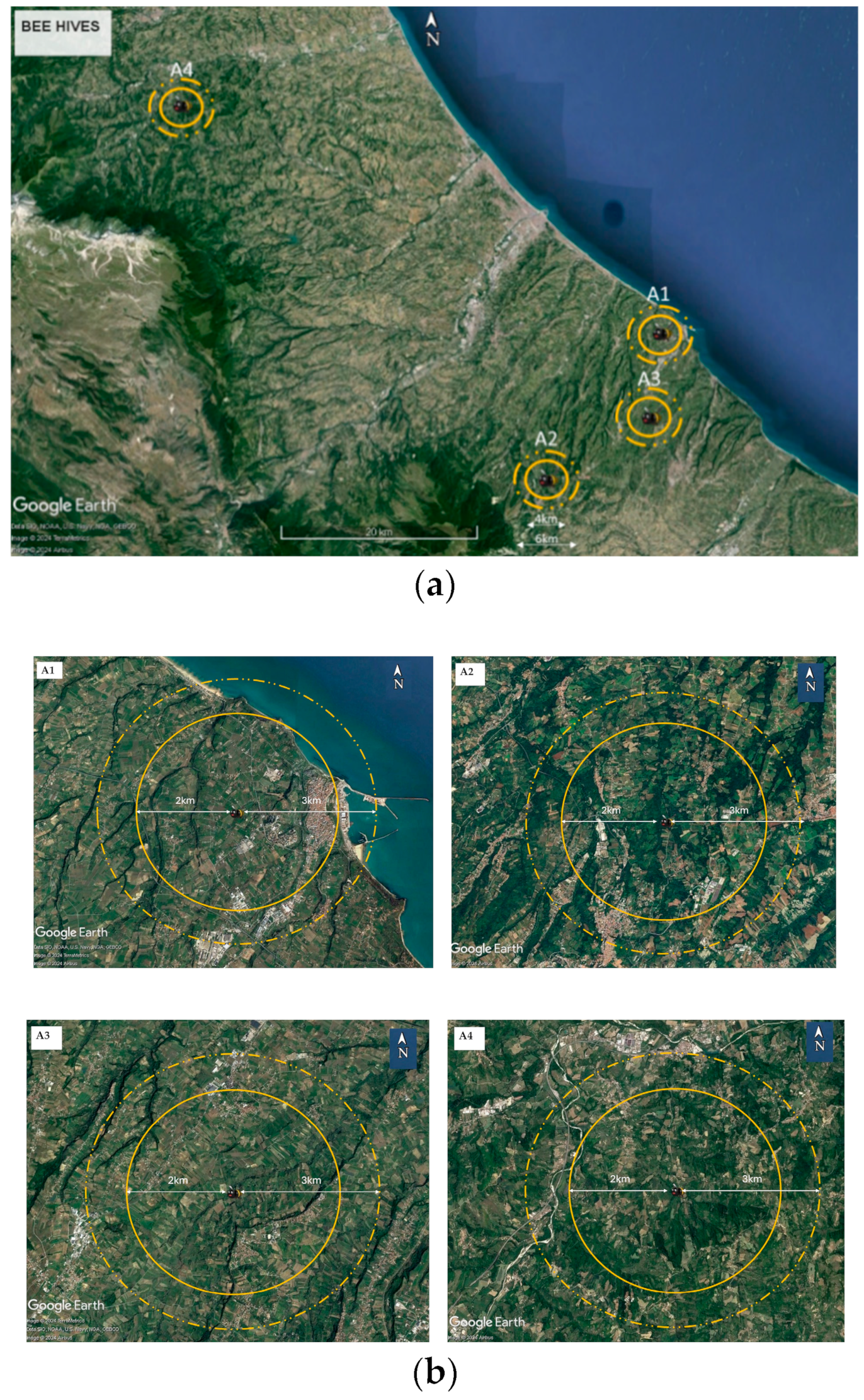
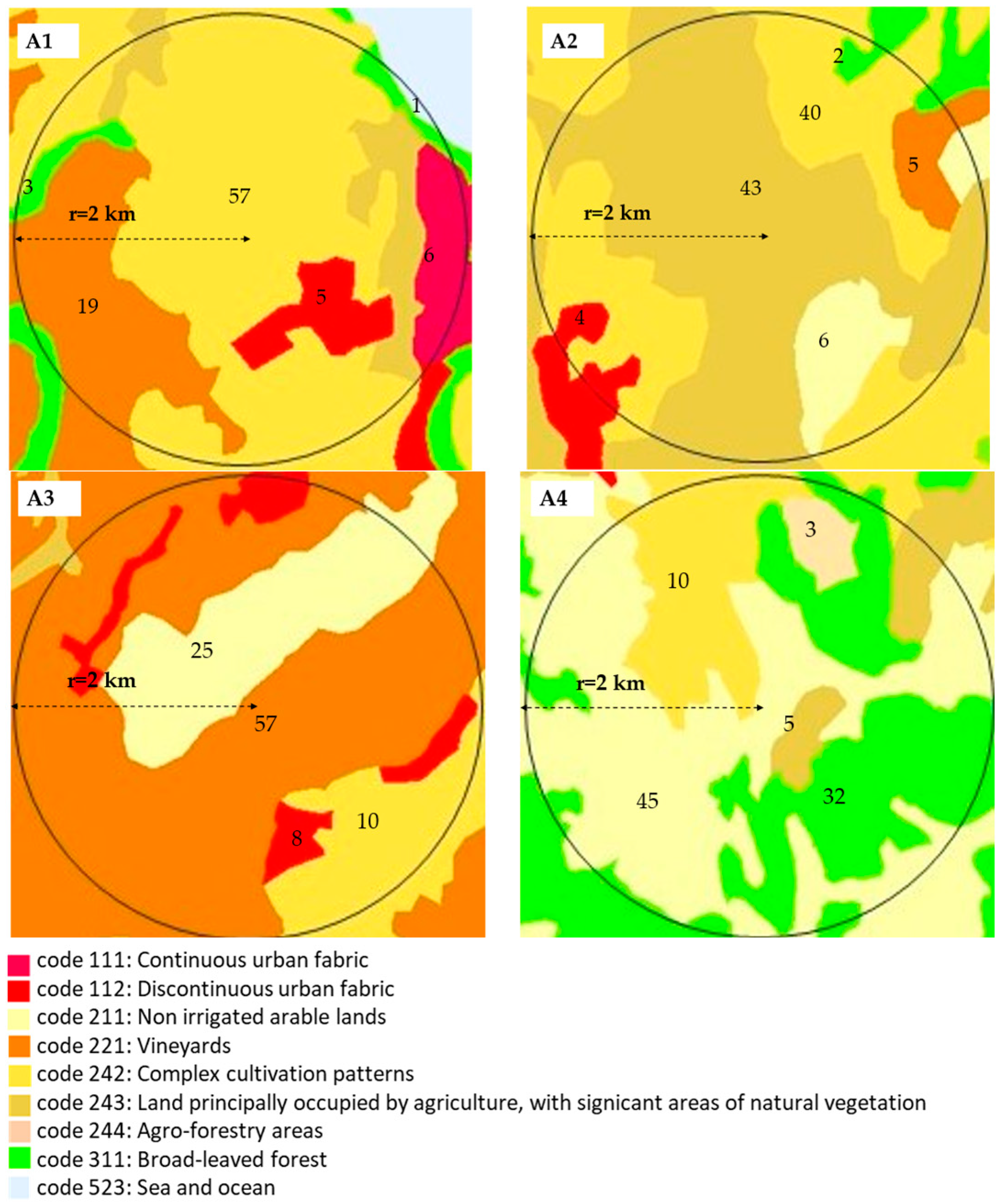
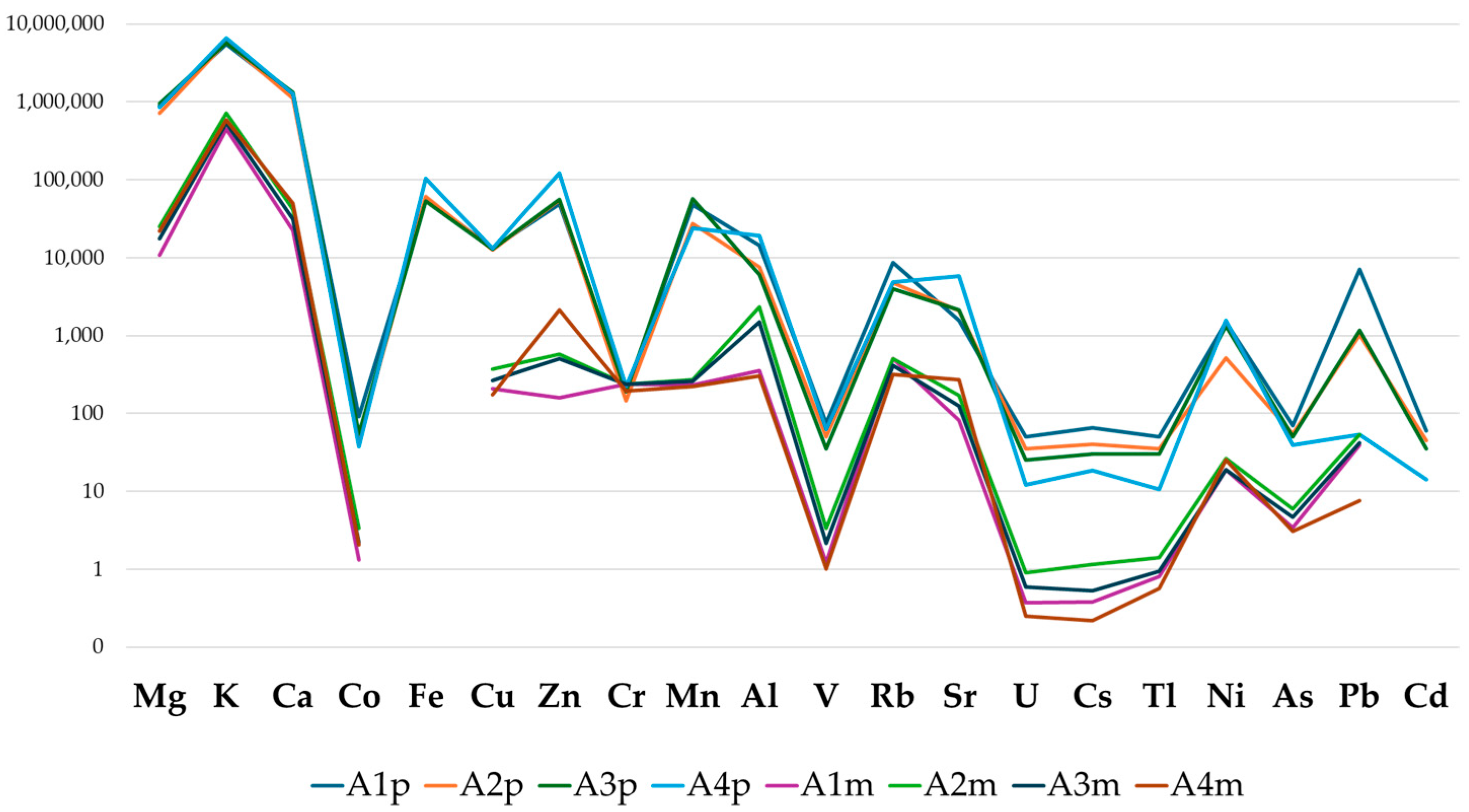
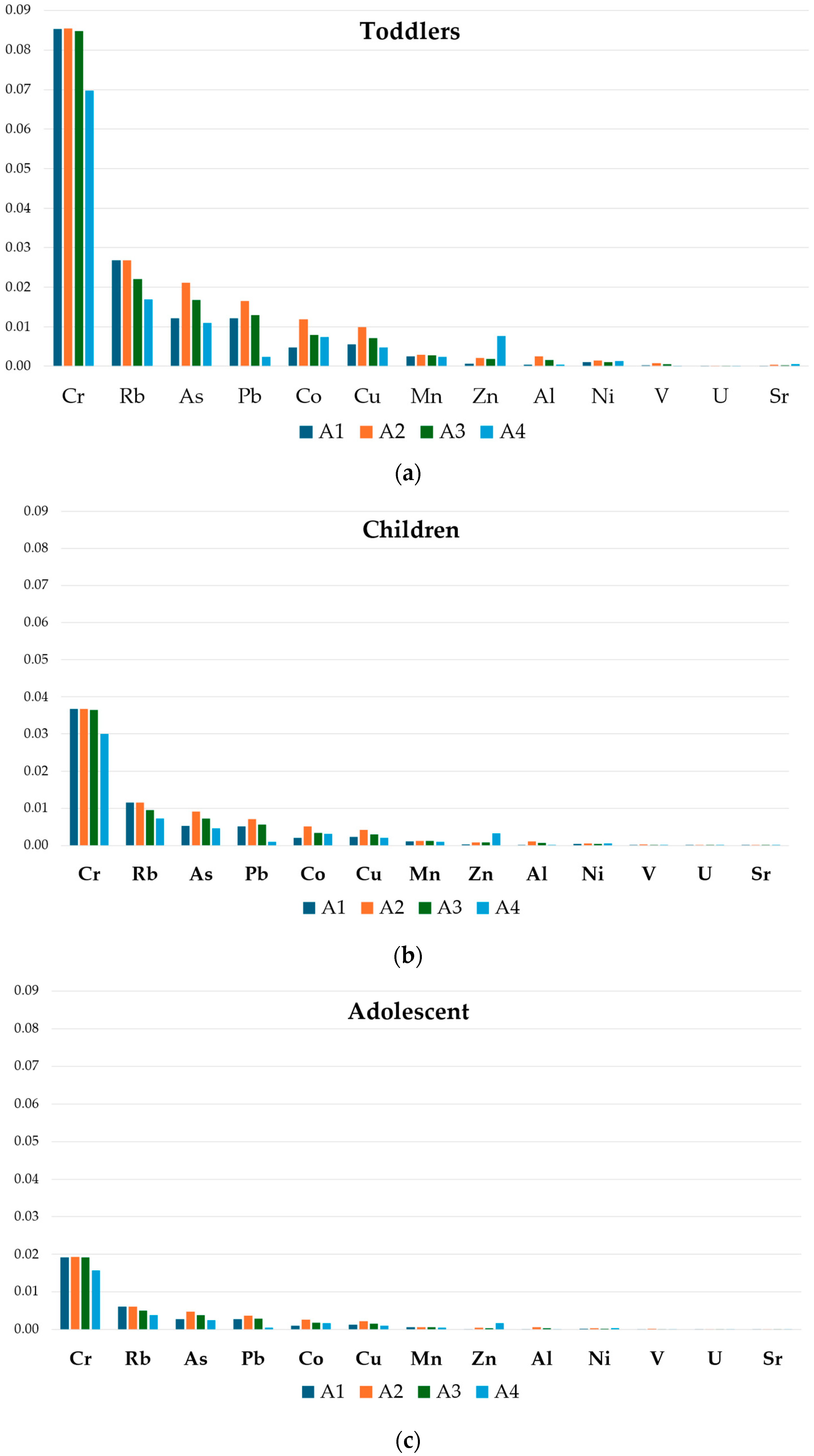

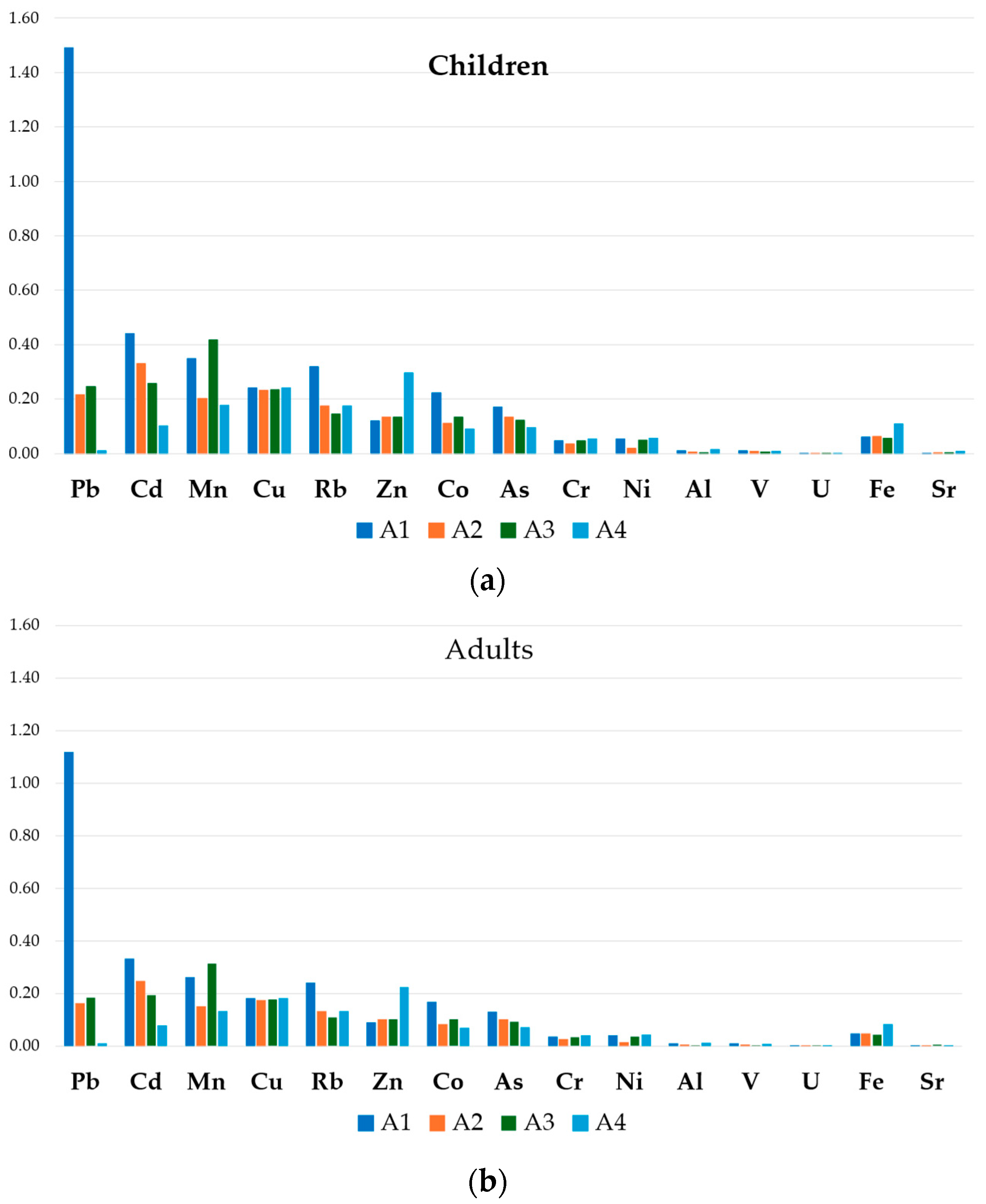
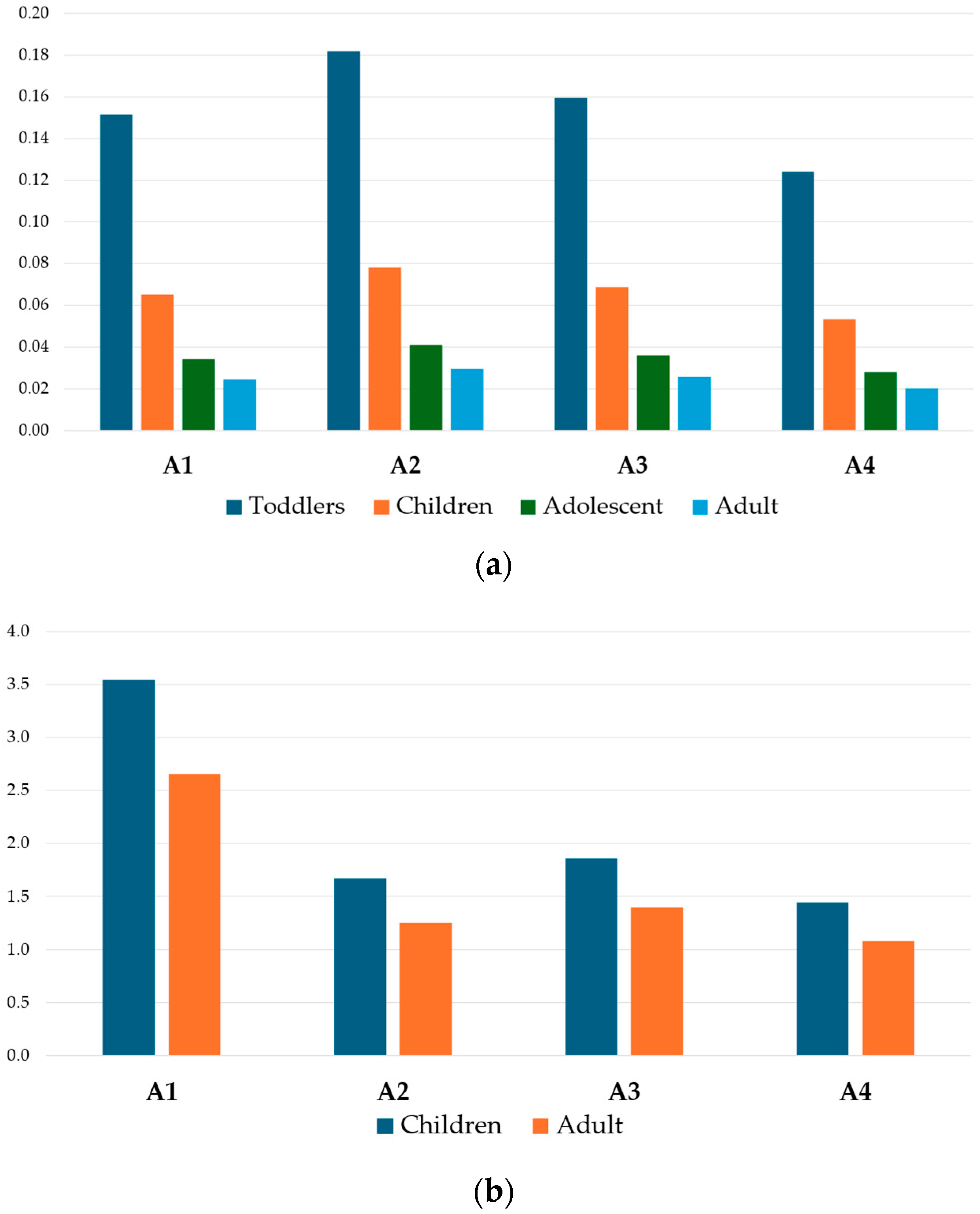


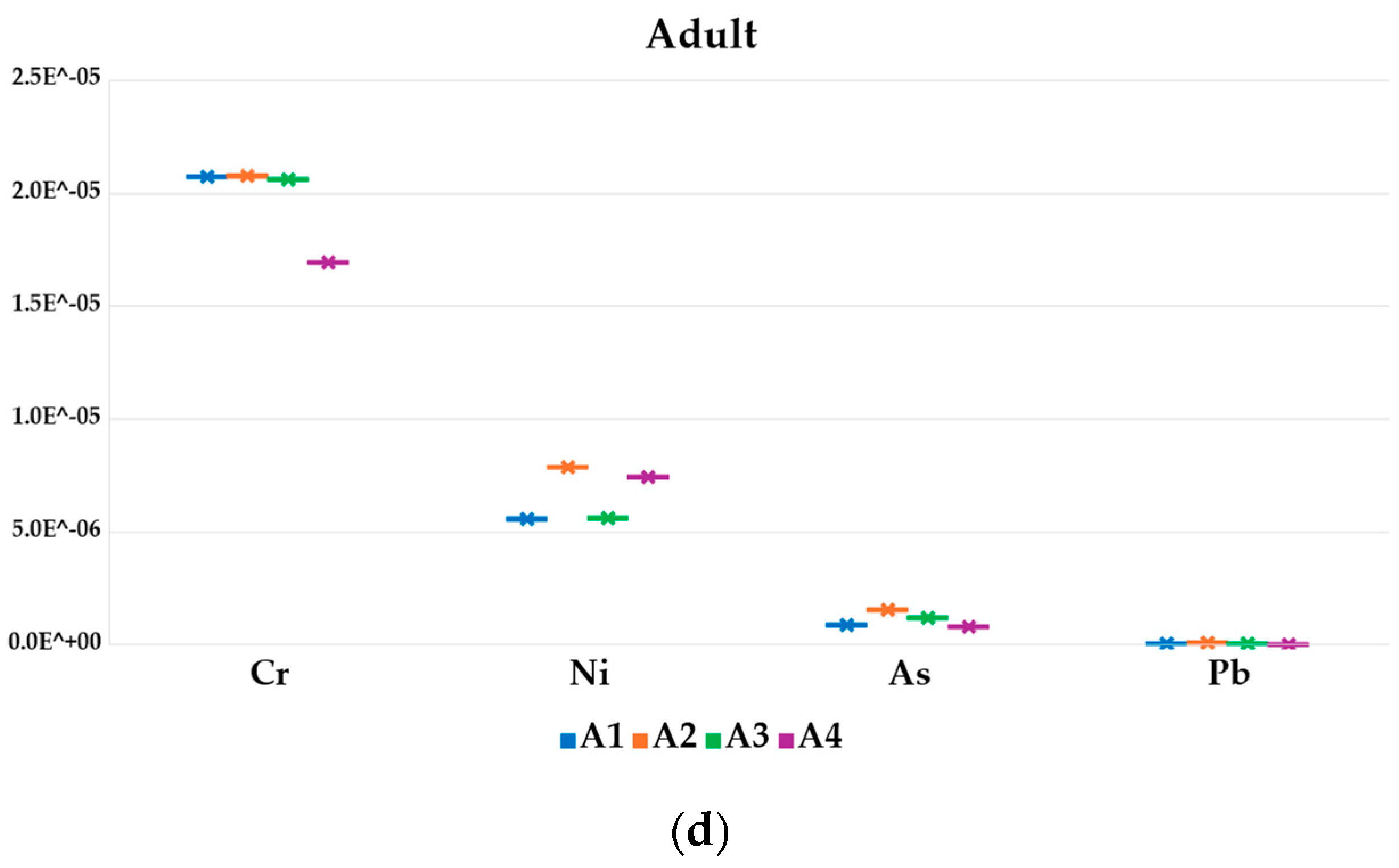
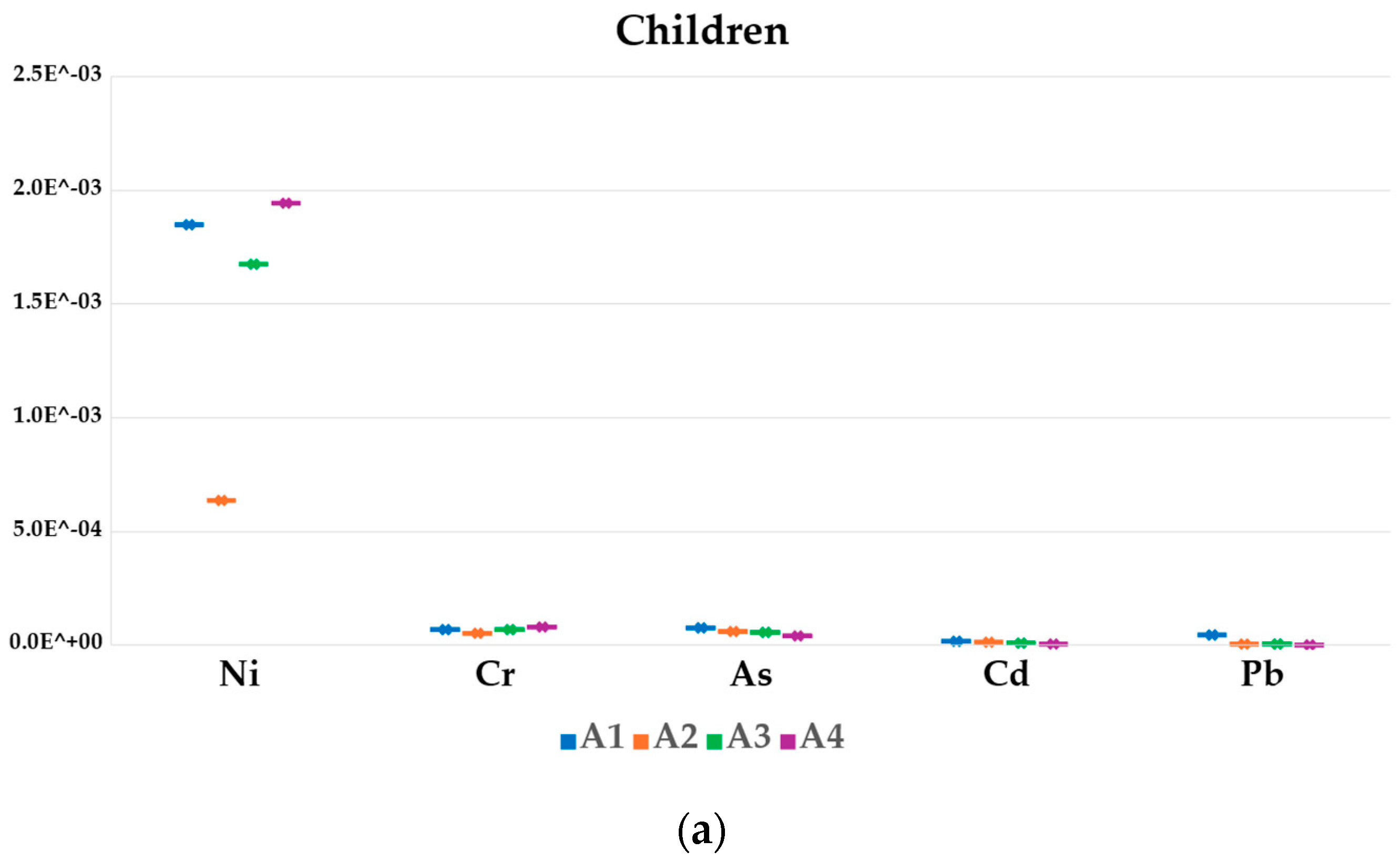
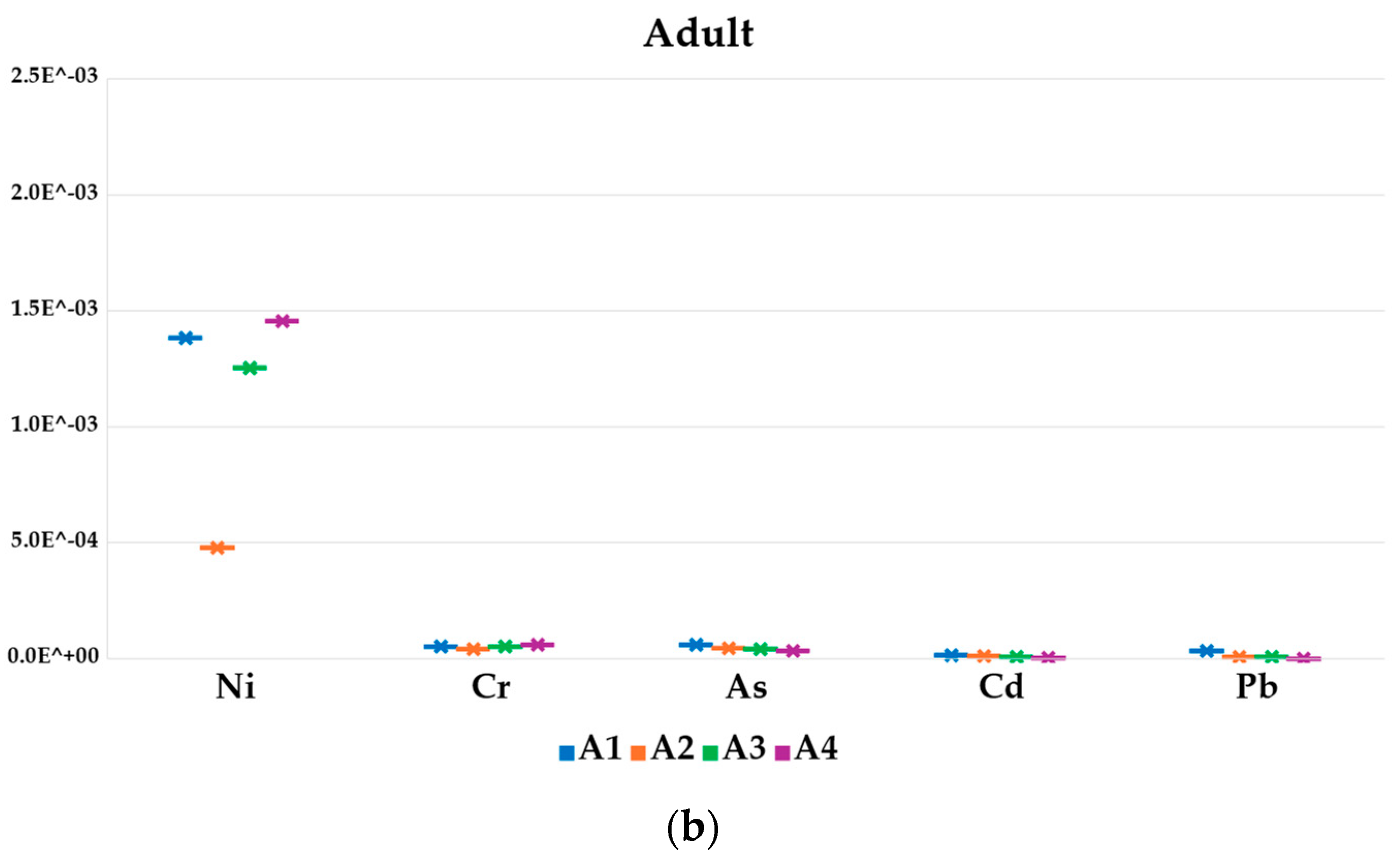

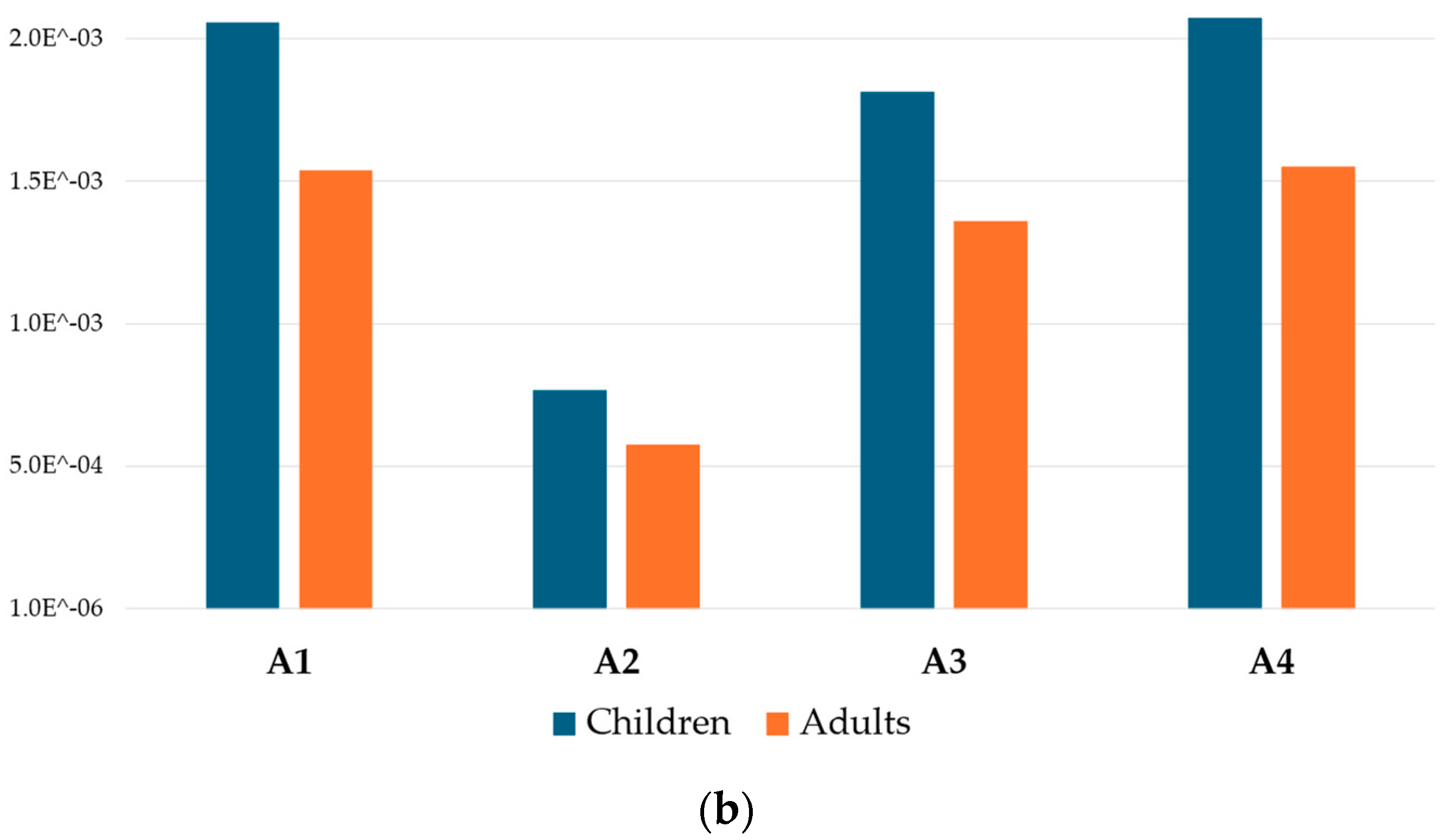
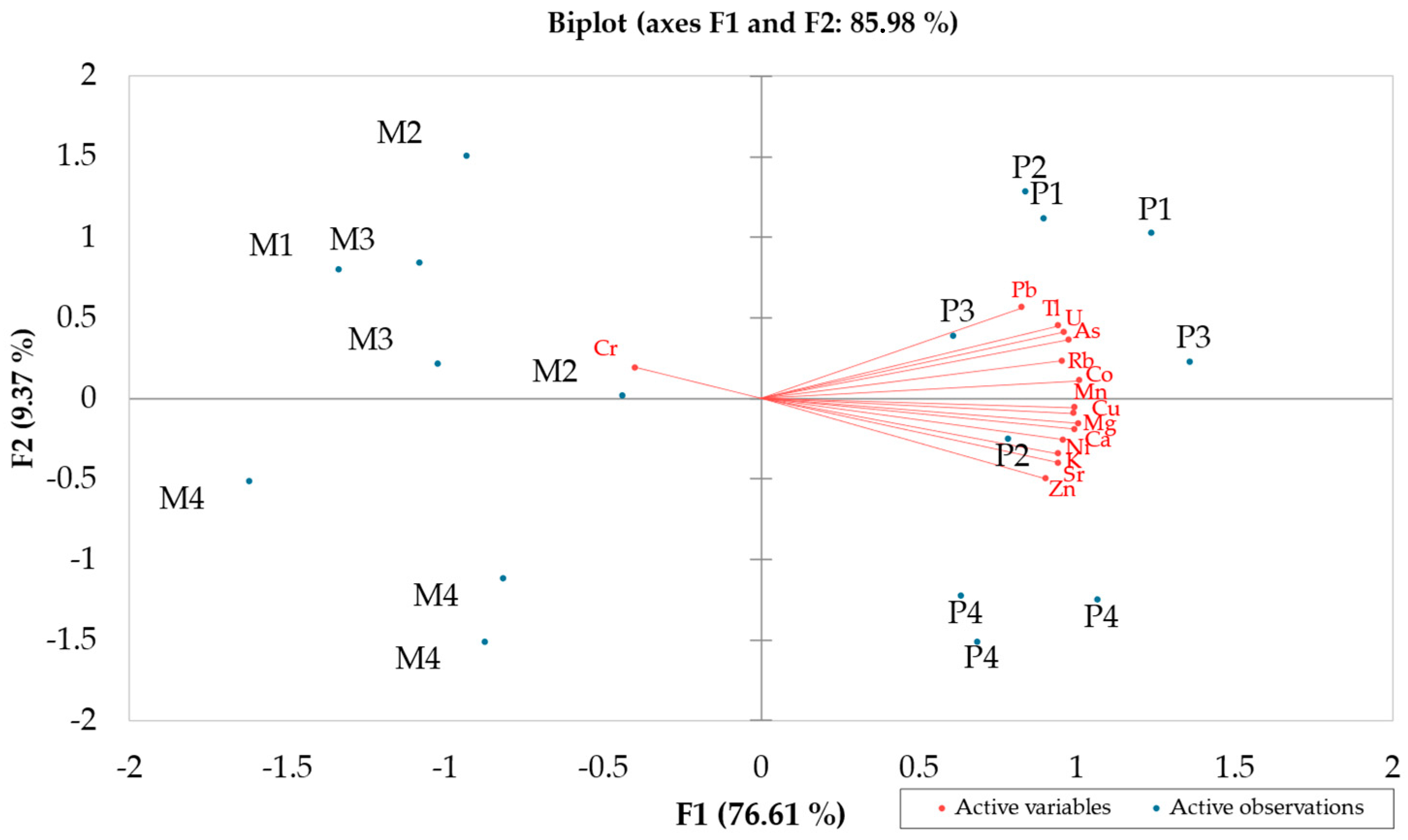
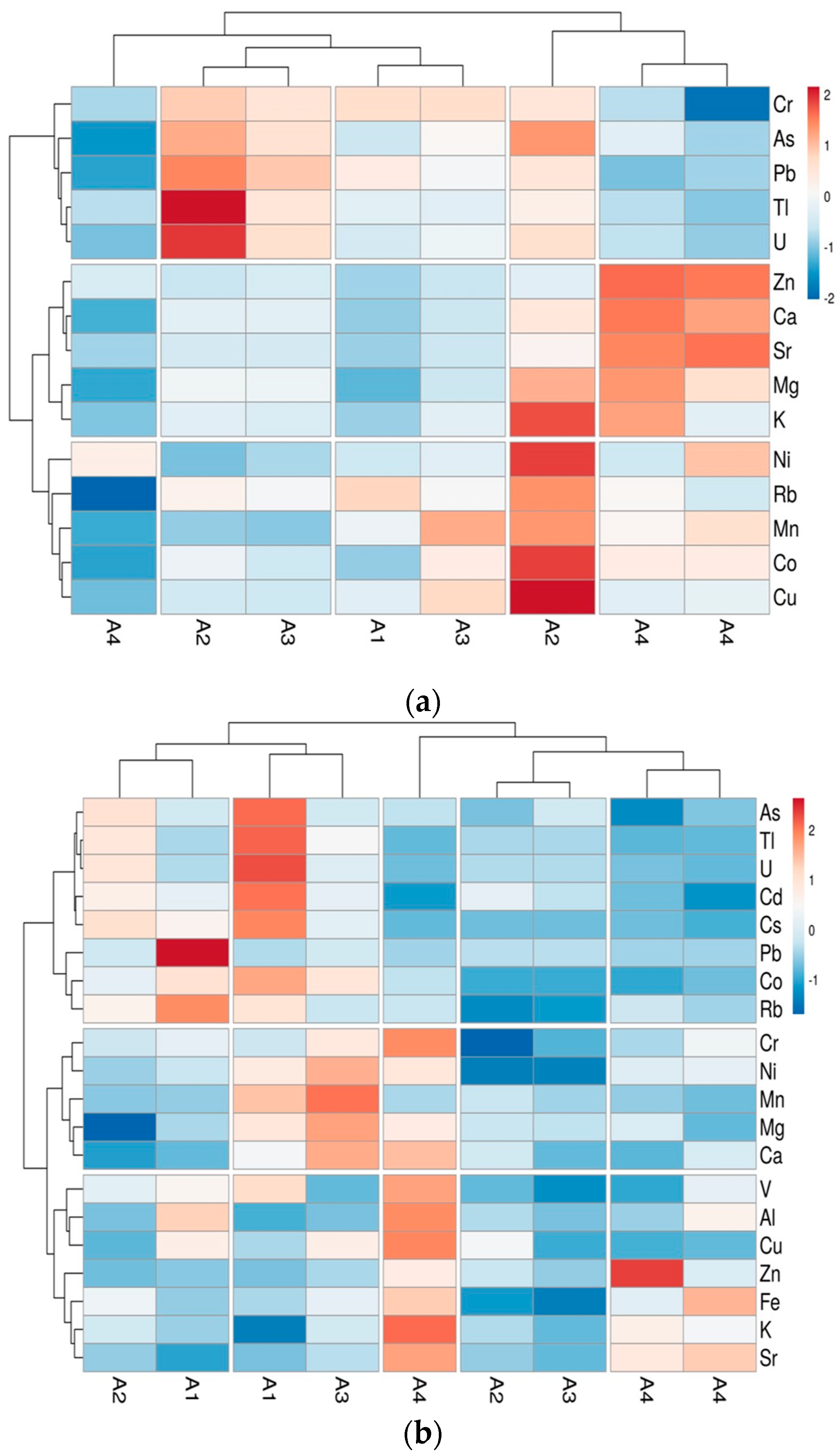
| Category | Years | Body Weight (BW) (kg) | Average Lifetime (AT) (Days) | Total Exposure (TE) (Years) | Intake Rate (IR) Honey A (kg/Day) | Intake Rate (IR) Bee Pollen B (kg/Day) |
|---|---|---|---|---|---|---|
| toddler | 0–3 | 11.3 | 730 | 2 | 0.0127 | - |
| children | 3–10 | 26.1 | 2555 | 7 | 0.0126 | 0.02 |
| adolescent | 10–18 | 52.6 | 2920 | 8 | 0.0133 | - |
| adult | 18–65 | 69.7 | 17155 | 47 | 0.0127 | 0.04 |
| Elements | RfD (mg/kgbw/Day) | Reference | CSF (mg/kgbw/Day) | Reference |
|---|---|---|---|---|
| [53] | / | |||
| Cd | 0.0001 | [51] | 0.38 | [62,64,65] |
| V | 0.005 ** | [51] | / | / |
| Cr | 0.003 *** | [51] | 0.50 | [66] |
| Ni | 0.02 ▴ | [51] | 1.70 ◦ | [66] |
| Cu | 0.04 | [51] | / | / |
| As | 0.0003 ▴▴ | [51] | 1.50 | [51] |
| Ba | 0.20 | [51] | / | / |
| Sb | 0.0004 ▴▴▴ | [51] | / | / |
| Pb | 0.0035 | [60,61,62,63] | 0.0085 ◦◦ | [66] |
| Mn | 0.10 | [51] | / | / |
| Al | 1 | [67] | / | / |
| Fe | 0.7 | [68] | / | / |
| Co | 0.0003 | [67] | / | / |
| Rb | 0.005 | [69] | / | / |
| Zn | 0.3 | [67] | / | / |
| U | 0.003 | [70] | / | / |
| Element | A1 2020 | A2 2019 | A2 2020 | A3 2019 | A3 2020 | A4 2019 | A4 2019 | A4 2020 |
|---|---|---|---|---|---|---|---|---|
| Mg | 10.875 ± 0.339 | 20.016 ± 1.163 | 29.496 ± 0.509 | 15.703 ± 0.940 | 19.547 ± 0.634 | 31.22 ± 0.849 | 9.584 ± 0.387 | 25.438 ± 0.175 |
| Al | 0.351 ± 0.042 | n.d | 2.314 ± 0.251 | 1.485 ± 0.066 | n.d. | 0.607 ± 0.021 | 0.117 ± 0.017 | 0.188 ± 0.008 |
| K | 445.962 ± 2.448 | 542.353 ± 20.797 | 885.447 ± 27.102 | 547.545 ± 6.164 | 532.569 ± 23.354 | 797.00 ± 3.030 | 423.783 ± 0.553 | 549.793 ± 5.435 |
| Ca | 22.155 ± 1.091 | 35.103 ± 1.269 | 48.314 ± 0.591 | 28.199 ± 1.977 | 34.665 ± 0.525 | 69.32 ± 0.465 | 15.217 ± 0.317 | 63.533 ± 0.964 |
| V | 0.001 ± 0.000 | 0.001 ± 0.000 | 0.005 ± 0.000 | 0.003 ± 0.000 | 0.001 ± 0.001 | 0.001 ± 0.000 | n.d | 0.001 ± 0.000 |
| Cr | 0.238 ± 0.008 | 0.243 ± 0.008 | 0.234 ± 0.004 | 0.238 ± 0.006 | 0.235 ± 0.008 | 0.205 ± 0.003 | 0.203 ± 0.001 | 0.176 ± 0.004 |
| Mn | 0.230 ± 0.008 | 0.131 ± 0.007 | 0.412 ± 0.011 | 0.388 ± 0.013 | 0.126 ± 0.009 | 0.261 ± 0.000 | 0.085 ± 0.001 | 0.320 ± 0.002 |
| Fe | n.d | n.d | n.d | n.d | n.d | n.d | n.d | n.d |
| Co | 0.001 ± 0.000 | 0.002 ± 0.000 | 0.004 ± 0.000 | 0.003 ± 0.000 | 0.002 ± 0.000 | 0.003 ± 0.000 | 0.001 ± 0.000 | 0.003 ± 0.000 |
| Ni | 0.019 ± 0.000 | 0.015 ± 0.002 | 0.038 ± 0.004 | 0.021 ± 0.003 | 0.017 ± 0.001 | 0.019 ± 0.001 | 0.026 ± 0.000 | 0.031 ± 0.000 |
| Cu | 0.206 ± 0.003 | 0.173 ± 0.010 | 0.564 ± 0.009 | 0.361 ± 0.019 | 0.167 ± 0.007 | 0.209 ± 0.005 | 0.091 ± 0.000 | 0.222 ± 0.005 |
| Zn | 0.157 ± 0.002 | 0.364 ± 0.046 | 0.778 ± 0.023 | 0.373 ± 0.056 | 0.639 ± 0.014 | 2.956 ± 0.095 | 0.602 ± 0.009 | 2.826 ± 0.067 |
| As | 0.003 ± 0.001 | 0.006 ± 0.001 | 0.006 ± 0.001 | 0.004 ± 0.000 | 0.005 ± 0.001 | 0.004 ± 0.001 | 0.002 ± 0.001 | 0.003 ± 0.000 |
| Rb | 0.499 ± 0.003 | 0.429 ± 0.017 | 0.567 ± 0.020 | 0.412 ± 0.027 | 0.408 ± 0.015 | 0.415 ± 0.027 | 0.175 ± 0.003 | 0.349 ± 0.004 |
| Sr | 0.081 ± 0.001 | 0.131 ± 0.008 | 0.205 ± 0.001 | 0.116 ± 0.009 | 0.131 ± 0.001 | 0.356 ± 0.005 | 0.086 ± 0.002 | 0.367 ± 0.006 |
| Cd | n.d | 0.0003 ± 0.0002 | n.d | n.d | n.d | n.d | n.d | n.d |
| Cs | 0.000 ± 0.000 | 0.001 ± 0.000 | 0.001 ± 0.000 | 0.000 ± 0.000 | 0.001 ± 0.000 | 0.000 ± 0.000 | n.d | 0.000 ± 0.000 |
| Tl | 0.001 ± 0.000 | 0.002 ± 0.000 | 0.001 ± 0.000 | 0.001 ± 0.000 | 0.001 ± 0.000 | 0.001 ± 0.000 | 0.001 ± 0.000 | 0.000 ± 0.000 |
| Pb | 0.039 ± 0.001 | 0.064 ± 0.003 | 0.002 ± 0.000 | 0.032 ± 0.002 | 0.052 ± 0.002 | 0.009 ± 0.001 | 0.001 ± 0.001 | 0.013 ± 0.000 |
| U | 0.000 ± 0.000 | 0.001 ± 0.000 | 0.000 ± 0.000 | 0.000 ± 0.000 | 0.001 ± 0.000 | 0.000 ± 0.000 | 0.000 ± 0.000 | 0.000 ± 0.000 |
| Element | A1 | A1 | A2 | A2 | A3 | A3 | A4 | A4 | A4 |
|---|---|---|---|---|---|---|---|---|---|
| Mg | 976 ± 104 | 798 ± 60 | 621 ± 1 | 819 ± 6 | 1089 ± 36 | 813 ± 35 | 857 ± 58 | 962 ± 47 | 751 ± 55 |
| Al | 4 ± 1 | 25 ± 2 | 6 ± 1 | 9 ± 1 | 6 ± 1 | 6 ± 1 | 8 ± 1 | 31 ± 1 | 18 ± 1 |
| K | 5185 ± 412 | 5711 ± 399 | 5930 ± 23 | 5787 ± 135 | 5929 ± 82 | 5543 ± 143 | 6370 ± 453 | 7186 ± 261 | 6229 ± 273 |
| Ca | 1328 ± 74 | 1066 ± 87 | 1001 ± 8 | 1212 ± 71 | 1591 ± 38 | 1067 ± 24 | 1059 ± 51 | 1549 ± 71 | 1231 ± 48 |
| V | 0.08 ± 0.02 | 0.07 ± 0.01 | 0.06 ± 0.05 | 0.04 ± 0.01 | 0.04 ± 0.03 | 0.03 ± 0.01 | 0.04 ± 0.01 | 0.09 ± 0.01 | 0.06 ± 0.01 |
| Cr | 0.18 ± 0.04 | 0.20 ± 0.01 | 0.18 ± 0.06 | 0.11 ± 0.02 | 0.23 ± 0.04 | 0.15 ± 0.02 | 0.17 ± 0.01 | 0.28 ± 0.01 | 0.21 ± 0.01 |
| Mn | 71 ± 3 | 24 ± 1 | 23 ± 1 | 32 ± 2 | 87 ± 4 | 27 ± 0.4 | 24 ± 1 | 28 ± 1 | 20 ± 1 |
| Fe | 60 ± 2 | 56 ± 4 | 82 ± 8 | 39 ± 2 | 78 ± 4 | 29 ± 1 | 76 ± 2 | 113 ± 3 | 120 ± 11 |
| Co | 0.10 ± 0.07 | 0.08 ± 0.01 | 0.06 ± 0.05 | 0.03 ± 0.01 | 0.08 ± 0.03 | 0.03 ± 0.01 | 0.03 ± 0.01 | 0.05 ± 0.004 | 0.04 ± 0.003 |
| Ni | 1.89 ± 0.01 | 1.07 ± 0.04 | 0.88 ± 0.09 | 0.14 ± 0.02 | 2.50 ± 0.20 | 0.18 ± 0.02 | 1.31 ± 0.01 | 1.96 ± 0.02 | 1.40 ± 0.10 |
| Cu | 12.3 ± 0.5 | 14.1 ± 0.7 | 11.7 ± 0.6 | 13.6 ± 0.8 | 14.1 ± 0.8 | 11.5 ± 0.2 | 11.6 ± 0.2 | 16.0 ± 0.2 | 11.8 ± 0.2 |
| Zn | 47.0 ± 0.4 | 51 ± 1 | 44 ± 3 | 65 ± 4 | 57 ± 3 | 53 ± 1 | 179 ± 8 | 109 ± 4 | 76 ± 2 |
| As | 0.09 ± 0.10 | 0.05 ± 0.02 | 0.07 ± 0.07 | 0.04 ± 0.02 | 0.05 ± 0.05 | 0.05 ± 0.02 | 0.03 ± 0.01 | 0.05 ± 0.01 | 0.04 ± 0.001 |
| Rb | 7.71 ± 0.07 | 9.70 ± 0.50 | 6.90 ± 0.70 | 2.60 ± 0.20 | 4.90 ± 0.40 | 3.00 ± 0.10 | 5.07 ± 0.10 | 4.90 ± 0.03 | 4.42 ± 0.04 |
| Sr | 1.90 ± 0.20 | 1.22 ± 0.001 | 2.10 ± 0.20 | 2.10 ± 0.10 | 2.60 ± 0.20 | 1.70 ± 0.09 | 4.87 ± 0.04 | 6.55 ± 0.01 | 5.78 ± 0.06 |
| Cd | 0.08 ± 0.10 | 0.04 ± 0.01 | 0.05 ± 0.06 | 0.04 ± 0.02 | 0.04 ± 0.04 | 0.03 ± 0.02 | 0.02 ± 0.01 | 0.01 ± 0.01 | 0.01 ± 0.003 |
| Cs | 0.08 ± 0.09 | 0.05 ± 0.01 | 0.06 ± 0.06 | 0.02 ± 0.01 | 0.04 ± 0.04 | 0.02 ± 0.02 | 0.02 ± 0.009 | 0.02 ± 0.01 | 0.02 ± 0.002 |
| Tl | 0.08 ± 0.09 | 0.02 ± 0.01 | 0.05 ± 0.06 | 0.02 ± 0.02 | 0.04 ± 0.04 | 0.02 ± 0.02 | 0.01 ± 0.01 | 0.01 ± 0.01 | 0.01 ± 0.003 |
| Pb | 0.40 ± 0.10 | 13.80 ± 0.70 | 1.40 ± 0.20 | 0.66 ± 0.06 | 1.70 ± 0.20 | 0.64 ± 0.04 | 0.05 ± 0.01 | 0.06 ± 0.01 | 0.05 ± 0.02 |
| U | 0.08 ± 0.09 | 0.02 ± 0.01 | 0.05 ± 0.06 | 0.02 ± 0.02 | 0.03 ± 0.04 | 0.02 ± 0.02 | 0.01 ± 0.010 | 0.01 ± 0.007 | 0.01 ± 0.003 |
Disclaimer/Publisher’s Note: The statements, opinions and data contained in all publications are solely those of the individual author(s) and contributor(s) and not of MDPI and/or the editor(s). MDPI and/or the editor(s) disclaim responsibility for any injury to people or property resulting from any ideas, methods, instructions or products referred to in the content. |
© 2024 by the authors. Licensee MDPI, Basel, Switzerland. This article is an open access article distributed under the terms and conditions of the Creative Commons Attribution (CC BY) license (https://creativecommons.org/licenses/by/4.0/).
Share and Cite
Flamminii, F.; Consalvo, A.; Cichelli, A.; Chiaudani, A. Assessing Mineral Content and Heavy Metal Exposure in Abruzzo Honey and Bee Pollen from Different Anthropic Areas. Foods 2024, 13, 1930. https://doi.org/10.3390/foods13121930
Flamminii F, Consalvo A, Cichelli A, Chiaudani A. Assessing Mineral Content and Heavy Metal Exposure in Abruzzo Honey and Bee Pollen from Different Anthropic Areas. Foods. 2024; 13(12):1930. https://doi.org/10.3390/foods13121930
Chicago/Turabian StyleFlamminii, Federica, Ada Consalvo, Angelo Cichelli, and Alessandro Chiaudani. 2024. "Assessing Mineral Content and Heavy Metal Exposure in Abruzzo Honey and Bee Pollen from Different Anthropic Areas" Foods 13, no. 12: 1930. https://doi.org/10.3390/foods13121930
APA StyleFlamminii, F., Consalvo, A., Cichelli, A., & Chiaudani, A. (2024). Assessing Mineral Content and Heavy Metal Exposure in Abruzzo Honey and Bee Pollen from Different Anthropic Areas. Foods, 13(12), 1930. https://doi.org/10.3390/foods13121930





